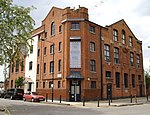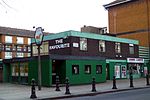The ClementJames Centre
Charities based in LondonEducation in LondonEducational charities based in the United KingdomEngvarB from June 2017
The ClementJames Centre is a UK education charity based in North Kensington, one of London's most disadvantaged areas. The charity's main message is that anyone has the potential to achieve their goals and succeed in life. By providing tailored support around education, employment, and wellbeing it breaks down barriers and empowers people to release their full potential.
Excerpt from the Wikipedia article The ClementJames Centre (License: CC BY-SA 3.0, Authors).The ClementJames Centre
Sirdar Road, London North Kensington (Royal Borough of Kensington and Chelsea)
Geographical coordinates (GPS) Address Website External links Nearby Places Show on map
Geographical coordinates (GPS)
| Latitude | Longitude |
|---|---|
| N 51.5119 ° | E -0.2153 ° |
Address
The ClementJames Centre
Sirdar Road 95
W11 4EG London, North Kensington (Royal Borough of Kensington and Chelsea)
England, United Kingdom
Open on Google Maps








